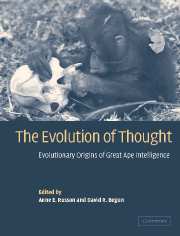Book contents
- Frontmatter
- Contents
- List of Contributors
- Preface
- 1 Evolutionary reconstructions of great ape intelligence
- 2 Enhanced cognitive capacity as a contingent fact of hominid phylogeny
- PART I COGNITION IN LIVING GREAT APES
- PART II MODERN GREAT APE ADAPTATION
- Introduction
- 7 What's in a brain? The question of a distinctive brain anatomy in great apes
- 8 Life histories and the evolution of large brain size in great apes
- 9 Evolution of complex feeding techniques in primates: is this the origin of great ape intelligence?
- 10 The special demands of great ape locomotion and posture
- 11 Great ape social systems
- 12 Diet and foraging of the great apes: ecological constraints on their social organizations and implications for their divergence
- PART III FOSSIL GREAT APE ADAPTATIONS
- Part IV INTEGRATION
- Author index
- Species index
- Subject index
11 - Great ape social systems
Published online by Cambridge University Press: 20 August 2009
- Frontmatter
- Contents
- List of Contributors
- Preface
- 1 Evolutionary reconstructions of great ape intelligence
- 2 Enhanced cognitive capacity as a contingent fact of hominid phylogeny
- PART I COGNITION IN LIVING GREAT APES
- PART II MODERN GREAT APE ADAPTATION
- Introduction
- 7 What's in a brain? The question of a distinctive brain anatomy in great apes
- 8 Life histories and the evolution of large brain size in great apes
- 9 Evolution of complex feeding techniques in primates: is this the origin of great ape intelligence?
- 10 The special demands of great ape locomotion and posture
- 11 Great ape social systems
- 12 Diet and foraging of the great apes: ecological constraints on their social organizations and implications for their divergence
- PART III FOSSIL GREAT APE ADAPTATIONS
- Part IV INTEGRATION
- Author index
- Species index
- Subject index
Summary
INTRODUCTION
Cognitive capacities may be more highly developed in most primates than among mammals in general (Tomasello & Call 1997), although other mammalian radiations such as cetaceans (e.g., Connor, Smolker & Richards 1992) and birds (e.g., Hunt 1996; Marler 1996) may have evolved similar capacities independently. Numerous studies have also suggested to some that great apes stand out among nonhuman primates in achieving more advanced cognitive abilities (e.g., Byrne 1995; Parker & Gibson 1990; Rumbaugh Savage-Rumbaugh & Washburn 1996; Russon, Bard & Parker 1996). Phenomena such as mirror self-recognition, imitation, pretend play, teaching, and manufacture and flexible use of tools have been cited as evidence that great apes, but not other nonhuman primates, have some form of self-concept, some ability to attribute mental states to others, and greater understanding of physical causality (Byrne 1995, 1997a; Byrne & Whiten 1997; Parker, Chapter 4, this volume; Russon 1997, Chapter 6, this volume; Russon & Bard 1996). Even skeptics note that great apes learn more rapidly than monkeys (Tomasello & Call 1997).
Our own recent meta-analysis of published studies on nonhuman primate cognition confirmed this assessment, that great apes are more intelligent than other nonhuman primates (Deaner et al. unpublished). It found that primate cognition is distinguished by some generalized capacity rather than a collection of narrow, problem- or domain-specific abilities, supporting the view that great apes constitute a homogeneous group that outranks other primates in cognitive performance.
- Type
- Chapter
- Information
- The Evolution of ThoughtEvolutionary Origins of Great Ape Intelligence, pp. 190 - 209Publisher: Cambridge University PressPrint publication year: 2004
- 8
- Cited by



